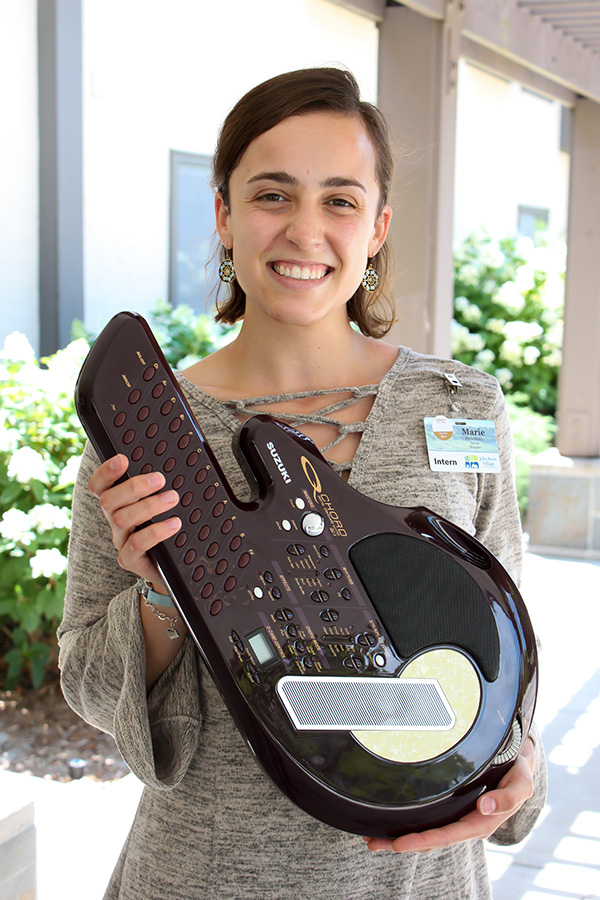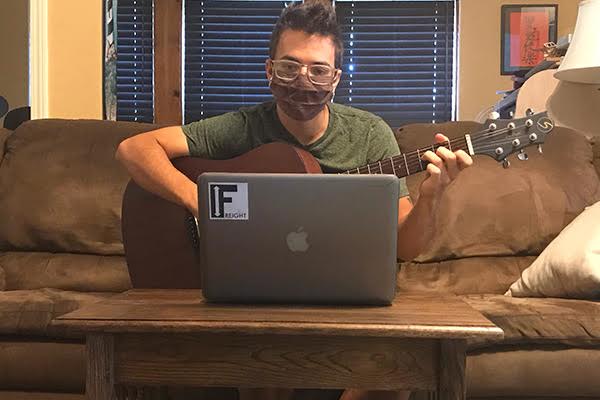How do you keep the music playing?
“And I saw my reflection in the snow-covered hills…”
As Maggie Ford performed Stevie Nicks’ folk rock classic “Landslide,” an anxious, restless patient in the med-psych unit relaxed and fell asleep within 10 minutes.
When Marie Reddy started to sing the hymn “Amazing Grace,” the face of a dying woman lit up with joy.
Over Zoom, Matthew Stevenson invited high school students with autism to sing along to a catchy tune about wearing a face mask in public. One boy, who couldn’t bear to wear a mask for five minutes, later donned one for 45 minutes during a visit to a shopping mall, to the relief of his mother.
It’s not easy being a music therapist amid a pandemic, but University of Dayton interns are learning how to keep the music playing — virtually and in-person — as they support patients in hospitals, clinics, hospice and therapy programs throughout the Midwest during their six-month required assignments.
“Being pulled out of hands-on therapy was hard on all these students,” conceded James Hiller, assistant professor and coordinator of the undergraduate music therapy program. “For all, but especially for those working in medical care, their supervisors rose to the occasion as best they could to initiate telehealth with their patients. The students learned new skills using technology, such as helping patients compose their own songs — of grief, fear, anxiety, gratitude, inspiration and frustration — as well as composing and performing music for their patients to soothe, calm and support them.
“There was great relief for those few permitted to return to limited hands-on interactions.”
Interns like Maggie Ford, who now dons scrubs and protective gear, grabs her guitar and sees patients several times a week at University Hospitals Connor Integrative Health Network in Cleveland. During three months of working remotely, she collaborated with a massage therapist and wrote and performed eight songs for children with cancer.
“Music touches people where words might not. It’s really powerful,” said Ford, who wraps up her internship this month and starts a job in a private practice in Columbia, Missouri. “This is exactly what I’m meant to do.”
For her patients at Village Hospice in Lee’s Summit, Missouri, Marie Reddy draws largely on a repertoire of jazz, big band tunes, religious hymns and music popular in the Roaring ‘20s and the swing era. In one session with a patient, she played a recording of a lively country tune as she danced with her granddaughter.
“With music therapy, we can help a patient relax by playing calming music. We can satisfy their spiritual needs with sacred music. It’s a unique and joy-inspiring medium,” said Reddy, who appreciates the art and science of her profession.
“A key component of Hospice is hope, but it’s realistic hope,” she said, pausing for a moment. “If we translate that to the pandemic, we have realistic hope, but we don’t have hope that it will magically disappear.”
In mid-August, Matthew Stevenson will return to Giant Steps, a special education school for students with autism spectrum disorders in Lisle, Illinois. For now, he’s living with his family in a Chicago suburb and offering remote sessions that help students improve their conversational skills, such as singing along to a made-up song “How Are You Today?” and working on self-regulation skills such as dancing to the childhood classic “The Hokey Pokey.”
In anticipation of his delayed return to the classroom, Stevenson said he’s practicing wearing a mask and singing.
“It’s tougher,” he said, “than you think.”

